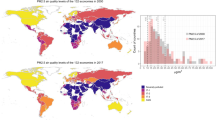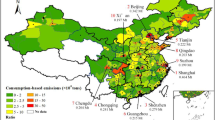Abstract
The utilization of economic capabilities to raise production in the economy enhances the industrial activities and use of transportation. These activities deteriorate the quality of the environment and raise the level of particulate matter (PM2.5). The objective of this study is to investigate the impact of economic capabilities and population agglomeration on PM2.5 emissions for the sample of 23 sub-Saharan African countries—a highly polluted region of the world. The study used panel regression from 2007 to 2015 and found that production capabilities are highly significant and directly effecting PM2.5 emissions. The Kuznets hypothesis does not hold in this region, and the concentration of population in urban areas is also significant. To avoid the problem of possible endogeneity in the empirical model and for robustness check, the study also utilized system GMM and found consistent results. The findings of the study are highly valuable to reduce PM2.5 and propose that the policymakers in Sub-Saharan African countries should opt for industrial specialization rather than economic complexity and ensure that the proper measures are taken to control PM2.5. Moreover, population concentrations should not be taken place in a few main urban cities.
Similar content being viewed by others
References
Aboubacar B, Xu D, Mahaman A, Bounbacar H (2018) The effect of PM2.5 from household combustion on life expectancy in sub-Saharan Africa. Int J Environ Res Public Health 15:748–761
Akumu J (2016) Improving Air Quality in African Cities. UNEP, Nairobi. Available from: http://www.unep.org/Transport/astf/pdf/Overview_AirPollution_Africa. (Access Date: 17-03-2020)
Albeaik S, Kaltenberg M, Alsaleh M, Hidalgo CA (2017) Improving the economic complexity index. arXiv preprint arXiv:1707.05826
Arellano M, Bover O (1995) Another look at the instrumental variable estimation of error-components models. J Econ 68(1):29–51
Athanasios L, Antonios G, Eirini B, Alexandra K (2019) Economic complexity and environmental performance: evidence from a world sample, MPRA Paper No. 92833, University Library of Munich, Germany. Munich
Blundell R, Bond S (1998) Initial conditions and moment restrictions in dynamic panel data models. J Econ 87(1):115–143
Chafe ZA, Brauer M, Klimont Z, Van Dingenen R, Mehta S, Rao S, Riahi K, Dentener F, Smith KR (2014) Household cooking with solid fuels contributes to ambient PM2.5 air pollution and the burden of disease. Environ Health Perspect 122(12):1314–1320
Cheng Z, Lina L, Wang S (2016) Status and characteristics of ambient PM2.5 pollution in global megacities. Environ Int 89-90:212–221
Dagadu HE, Patterson EJ (2015) Placing a health equity Lens on non-communicable diseases in sub-Saharan Africa. J Health Care Poor Underserved 26(3):967–989
Dalal S, Beunza JJ, Volmink J, Adebamowo C, Bajunirwe F, Njelekela M, Mozaffarian D, Fawzi W, Willett W, Adami H, Holmes MD (2011) Non-communicable diseases in sub-Saharan Africa: what we know now. Int J Epidemiol 40(4):885–901
Dinda S (2004) Environmental Kuznets curve hypothesis: a survey. Ecol Econ 49(4):431–455
Dinda S, Coondoo D, Pal M (2000) Air quality and economic growth: an empirical study. Ecol Econ 34(3):409–423
Egondi T, Ettarh R, Kyobutungi C, Ng N, Rocklöv J (2018) Exposure to outdoor particles (PM2.5) and associated child morbidity and mortality in socially deprived neighborhoods of Nairobi, Kenya. Atmosphere 9:351. https://doi.org/10.3390/atmos9090351
Erickson LE, Jennings M (2017) Energy, transportation, air quality, climate change, health nexus: Sustainable energy is good for our health. AIMS Public Health 4(1):47–61
Faria MV, Duarte GO, Baptista PC, Farias TL (2017) Scenario-based analysis of traffic-related PM 2.5 concentration: Lisbon case study. Environ Sci Pollut Res 24(13):12026–12037
Ferronato N, Torretta V (2019) Waste mismanagement in developing countries: a review of global issues. Int J Environ Res Public Health 16(6):1060.
Fudala J (2013) Particulate Matter in Atmospheric Air in Urban Agglomeration. J Ecol Eng 18(3):149–155
Gaita MS, Boman J, Gichuru GJM (2014) Source apportionment and seasonal variation of PM2.5 in a sub-Saharan African city: Nairobi, Kenya. Atmos Chem Phys 14(7):9565–9601
Halicioglu F (2009) An econometric study of CO2 emissions, energy consumption, income and foreign trade in turkey. Energy Policy 37(3):1156–1164
Hausmann R, Hidalgo CA, Bustos S, Coscia M, Simoes A, Yildirim MA (2014) The atlas of economic complexity: mapping paths to prosperity. MIT Press. https://mitpress.mit.edu/books/atlas-economic-complexity (Access Date: 26-02-2020)
Hussein MA (2010) Energy and sustainable development: environmental impacts of energy use in Africa. In: Gökçekus H, Türker U, LaMoreaux J (eds) Survival and Sustainability. Environmental Earth Sciences. Springer, Berlin, Heidelberg
Katoto PDMC, Byamungu L, Brand AS, Mokaya J, Strijdom H, Goswami N, Boever PD, Nawrot TS, Nemery B (2019) Ambient air pollution and health in Sub-Saharan Africa: current evidence, perspectives and a call to action. Environ Res 173:174–184
Kinney PL (2011) Traffic impacts on PM2.5 air quality in Nairobi, Kenya. Environ Sci Policy 14(4):369–378
Landrigan PJ, Fuller R, Acosta NJ, Adeyi O, Arnold R, Baldé AB et al (2018) The Lancet commission on pollution and health. Lancet 391(10119):462–512
Le T, Chang Y, Park D (2016) Trade openness and environmental quality: International evidence, Energy Policy 92:45–55
Lemprière M (2016) Using ecological modernisation theory to account for the evolution of the zero-carbon homes agenda in England. Environ Politics 25(4):690–708
Li H, You S, Zhang H, Zheng W, Zheng X, Jia J, Ye T, Zou L (2017) Modelling of AQI related to building space heating energy demand based on big data analytics. Appl Energy 203:57–71
Lin B, Zhu J (2019) The role of renewable energy technological innovation on climate change: Empirical evidence from China. Sci. Total Environ 659: 1505–1512
Liu X, Liang X, Li X, Xu X, Ou J, Chen Y, Li S, Wang S, Pei F (2017) A future land use simulation model (FLUS) for simulating multiple land use scenarios by coupling human and natural effects. Landsc Urban Plan 168:94–116
Martins F, Felgueiras C, Smitkova M, Caetano N (2019) Analysis of fossil fuel energy consumption and environmental impacts in European countries. Energies 12(6):964
Maruotti A (2011) The impact of urbanization on CO2 emissions: evidence from developing countries. Ecol Econ 70(7):1344–1353
Mol AP (2000) The environmental movement in an era of ecological modernisation. Geoforum 31(1):45–56
Muhammad S, Tiwari A, Nasir M (2013) The effects of financial development .economic growth, coal consumption and trade openness on environment performance in south Africa. Energy Policy 61(C):1452–1459
Nyaaba GN, Stronks K, Aikins ADG, Kengne AP, Agyemang C (2017) Tracing Africa’s progress towards implementing the non-communicable diseases global action plan 2013–2020: a synthesis of WHO country profile reports. BMC Public Health 17(1):297
Nyirenda MJ (2016) Non-communicable diseases in sub-Saharan Africa: understanding the drivers of the epidemic to inform intervention strategies. Int Health 8(3):157–158
OECD. The cost of air pollution; 2014 http://www.oecd.org/regional/the-cost-ofairpollution- 9789264210448-en.htm (Access Date: 08-01-2020)
Ozturk I (2015) Measuring the impact of energy consumption and air quality indicators on climate change: evidence from the panel of UNFCC classified countries. Environ Sci Pollut Res 22(20):15459–15468
Richmond AK, Kaufmann RK (2006) Is there a turning point in the relationship between income and energy use and/or carbon emissions? Ecol Econ 56(2):176–189
Roodman D (2009) How to do xtabond2: An introduction to difference and system GMM in Stata. Stata J 9(1):86–136
Salameh D, Detournay A, Pey J, Pérez N, Liguori F, Saraga D, Bove MC, Brotto P, Cassola F, Massabo D, Latella A, Pillon S, Forementon G, Patti S, Armengaud A, Piga D, Jaffrezo JL, Bartzis J, Tolis E, Prati P, Querol X (2015) PM2.5 chemical composition in five European Mediterranean cities: a 1-year study. Atmos Res 155:102–117
Schurer S, Yong J (2012) Personality, well-being and the marginal utility of income: What can we learn from random coefficient models? Health, Econometrics and Data Group (HEDG) Working Papers 12/01, HEDG, c/o Department of Economics, University of York
Schwela D (2012). Review of urban air quality in Sub-Saharan Africa region: air quality profile of SSA countries. World Bank, Washington, DC. World Bank. https://openknowledge.worldbank.org/handle/10986/26864 License: CC BY 3.0 IGO (Access Date: 08-12-2019)
Shahbaz M, Lean HH, Shabbir MS (2012) Environmental Kuznets Curve hypothesis in Pakistan: cointegration and granger causality. Renew Sustain Energy Rev 16(5):2947–2953
Sitas F, Parkin DM, Chirenje M, Stein L, Abratt R, Wabinga H (2008) Part II: Cancer in Indigenous Africans—causes and control. Lancet Oncol 9(8):786–795
Vliet EBS, Kinney PL (2007) Impacts of roadway emissions on urban particulate matter concentrations in sub-Saharan Africa: new evidence from Nairobi, Kenya. Environ Res Lett 2(4):1–5
Wang S, Fang C, Guan X, Pang B, Ma H (2014) Urbanization, energy consumption, and carbon dioxide emissions in China: a panel data analysis of China’s provinces. Appl Energy 136:738–749
Wang Y, Liu H, Mao G, Zuo J, Ma J (2017) Inter-regional and sectoral linkage analysis of air pollution in Beijing–Tianjin–Hebei (Jing-Jin-Ji) urban agglomeration of China. J Clean Prod 165:1436–1444
Wang N, Guo H, Peng C (2018) The heterogeneous effect of democracy, political globalization, and urbanization on PM2.5 concentrations in G20 countries: evidence from panel quantile regression. J Clean Prod 194:54–68
Wang Q, Pokwan M, Zhou K, Fan J, Zhan D (2019) The impacts of urbanization on fine particulate matter (PM2.5) concentrations: empirical evidence from 135 countries worldwide. Environ Pollut 247:989–998
WHO. Ambient (outdoor) air quality and health; 2014. http://www.who.int/ mediacentre/factsheets/fs313/en/ (Access Date: 08-03-2020)
Wu W-L (2017) Institutional quality and air pollution: international evidence. Int J Bus Econ 16(1):49–74
Xu B, Lin B (2015) How industrialization and urbanization process impacts on CO2 emissions in China: evidence from nonparametric additive regression models. Energy Econ 48:188–202
Yang D, Chao Y, Wang X, Lu Deblin XJ, Yang H (2018) Global distribution and evolvement of urbanization and PM2.5 (1998-2015). Atmos Environ 182:171–178
York R, Rosa EA, Dietz T (2003) STIRPAT, IPAT and ImPACT: analytic tools for unpacking the driving forces of environmental impacts. Ecol Econ 46(3):351–365
Zhou C (2018) Examining the effects of socio-economic development on fine particulate matter (PM2.5) in China’s cities using spatial regression and the geographical detector technique. Sci Total Environ 6(2):436–445
Acknowledgments
The authors would like to appreciate the Economics and Chemical Engineering Departments of COMSATS University Islamabad (CUI), Lahore campus, Lahore, Punjab, Pakistan, for providing research facilities.
Author information
Authors and Affiliations
Corresponding author
Additional information
Responsible Editor: Philippe Garrigues
Publisher’s note
Springer Nature remains neutral with regard to jurisdictional claims in published maps and institutional affiliations.
Rights and permissions
About this article
Cite this article
Malik, S., Iqbal, A., Imran, A. et al. Impact of economic capabilities and population agglomeration on PM2.5 emission: empirical evidence from sub-Saharan African countries. Environ Sci Pollut Res 28, 34017–34026 (2021). https://doi.org/10.1007/s11356-020-10907-9
Received:
Accepted:
Published:
Issue Date:
DOI: https://doi.org/10.1007/s11356-020-10907-9




